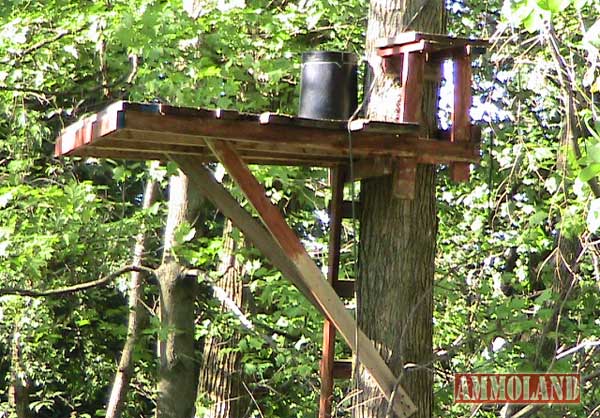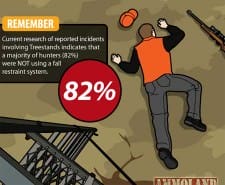

USA –-(Ammoland.com)- The first commercial tree stands were sold in the 1970s and today there are more than 100 manufacturers, according to the Treestand Manufacturers Association via USA Today.
They are most commonly used by hunters in the Midwest and South to improve their vantage point for that perfect kill shot.
Still, old-school hunters would rather build their own stand than buy one off the shelf.
The primary knock against using treestands for hunting is safety. Despite the popular belief that most hunting accidents resulting in hospitalization are due to accidental gun shot wounds, treestand falls are far more common.

A 10-year study by Ohio State University Medical Center found that 50 percent of patients admitted to the hospital for hunting-related injuries suffered falls, most of them from treestands. Only 29 percent of injuries were attributed to gunshot wounds, with more than half of them being self-inflicted.
Treestands are simple to build, but shoddy construction is what leads to many falls and other accidents.
Keep all of the following in mind when constructing your treestand:
Legal Issues
Federal law regulates the use of treestands in national forests and parks. They must be a portable tree stand and taken with you at the conclusion of your hunting trip. It is illegal to remove limbs and to drive screws and nails into a tree on federal land, as well. In other words, you’re better off buying a treestand that mounts with ratchet straps in these situations.
State laws vary as they pertain to treestands. Vermont, for instance, prohibits permanent treestands in state wildlife management areas. Iowa prohibits them on all public lands. Contact your local fish and game department before commencing any treestand construction project.
Ladder
If you are going to construct your own, the ideal height for a treestand is between 15 and 25 feet. The ladder is the first item to construct. You’ll need two 2X4 beams at the length/height you choose, along with several more for rungs and steps. Lie the 2X4’s down flat and parallel, and attached the steps one foot apart with nails or screws. The support rungs should be attached to the back. Its best to affix them diagonally between every three steps.
The ladder can be secured to the tree with rope, chains, or even ratchet straps. Make sure it’s tight enough so the ladder doesn’t shift, but loose enough so the wood isn’t damaged over time by pressure.
The Perch
A plywood platform that is at least 3/4 of an inch thick, along with a couple more 2X4’s for bracing, are necessary for this step. The most important part of building the perch is to ensure it can support your weight and is easy to climb on from the ladder. Safety comes first when attaching the platform. If you are building a platform on your own land and have easy access, consider renting a scissorlift to complete this portion.
Construct a triangular-shaped frame for the platform as shown in this video. The supports should be attached to the tree with at least two screws or nails on each side. The platform is then be nailed to the frame. A lawn or fishing chair can easily be carried up and back down when your trip concludes.
Additional Safety and Setup Tips
The Minnesota Department of Natural Resources recommends hunters wear a safety harness when using a treestand. A makeshift one can be constructed from rope or you can purchase one for as little as $30. Always follow the 3-Point Rule for safety when it comes to ladders. That means both feet and one hand, or one foot and two hands should be in contact with the ladder at all times while climbing.
A great way to create cover on a naked tree is with flag brackets. Attach them to your perch and hang loose evergreen or other deciduous branches that hold leaves late into autumn from them.
A treestand can be constructed cheaply and quickly, but never cut corners that will compromise safety.
